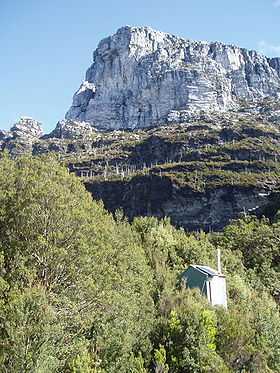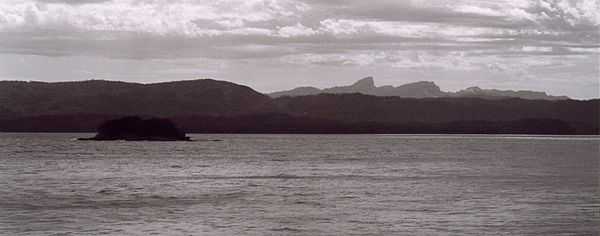Frenchmans Cap
| Frenchmans Cap | |
|---|---|
 View of Frenchmans Cap from near Lake Tahune Hut | |
| Elevation | 1,446 m (4,744 ft) |
| Location | |
| Location | Tasmania, Australia |
| Coordinates | 42°16′10.93″S 145°49′49.18″E / 42.2697028°S 145.8303278°E |
Frenchmans Cap is a prominent mountain in the Franklin-Gordon Wild Rivers National Park, Western Tasmania, Australia. It lies east of the West Coast Range, and south-west of the Cradle Mountain-Lake St Clair National Park. It was well known to Aborigines, and one of its names was Mabarlek.
Naming
Even though the peak was an early landmark for ships sailing the west coast, the first recorded use of Frenchmans Cap was in 1822 in connection with Macquarie Harbour Penal Station, from where the peak was visible. The origin of the name is a mystery but is attributed to its appearance from some angles as looking like a Frenchman's cap, notably the Liberty cap worn during the French Revolution (1789–1799).[1]
A variation of that was reported by Henry Widdowson, who wrote in 1829 that the name was derived from "its generally being covered with snow and bearing some resemblance to the shape of dress which invariably adorns the head of a French Cook".[1]
History
The distinctive shape of the mountain was used as a guiding beacon by many, largely unsuccessful, parties of escaping convicts as they attempted to struggle through the dense scrub of Western Tasmania to the settled districts further east. It was mentioned as a geographical reference in the account later dictated by convict Alexander Pearce to authorities, following his capture.[1]
The earliest European recorded to have ascended was James Sprent and his trigonometrical party in 1853.
In 1941 the Frenchmans Cap National Park was created and its boundary was in effect the Franklin River. This park was subsumed into the Franklin-Gordon Wild Rivers National Park in the 1990s.
The country around the mountain is invariably referred to by the books and the material written about the Franklin River. Johnson Dean's book gives a graphic account with maps and pictures the nature of the country. Phil Robinson's book evocatively describes the climbing history until 1979.
Hiking, climbing
The walk to the peak along the well marked track typically takes two days. The first day of about 16 km will bring walkers to Lake Vera Hut. This part of the walk includes two steep and prolonged ascents separated by the boggy Loddon Plains. The so-called "Sodden Loddons" are almost always muddy and crossing them may take two hours or more. In wet weather the mud can be waist high. In summer it is only knee high. Water is plentiful (and drinkable) in all seasons. Walk time from Lyell Highway to Lake Vera is between six and eight hours.
The second day's walk is shorter at 9 km, but steeper. After walking along the shores of Lake Vera the next two hours are spent struggling up the steep inclines to Barron Pass. Once on top the walker is presented with a dramatic view of the majestic Frenchmans Cap. From Barron Pass it is approximately another two hours to Tahune Hut, depending on fitness and pack weight. Water is again available along the way. Walk time from Lake Vera to Lake Tahune is about four hours.
There are two lakes on the way to the summit – Lake Vera, and Lake Tahune – there are huts at both of these locations. Lake Vera Hut was built in 1979 and sleeps 20 people in two two-tier bunk configurations.[2] It is heated by a coal stove. Lake Tahune Hut was built in 1971 and sleeps 16 people snugly, also in two two-tier bunks.[2] It is heated by a methylated spirits stove.
At Tahune, the steep walker's track to the top of the Cap takes under an hour. If the weather is clear the view includes the West Coast beaches, Lake Burbury and the many peaks – such as Tasmania's tallest, Mount Ossa – in the Cradle Mountain-Lake St Clair National Park.
The 50 km-plus walk to Frenchmans Cap is typically completed as a return trip on the same track. There is an option to make it a round trip by walking on from Lake Tahune to the Franklin River at Irenabyss, crossing the river and exiting at Victoria Pass, which is also on the Lyell Highway. The walk from Irenabyss to Victoria Pass traverses rugged country and is recommended only for highly experienced parties. Many parties visit Irenabyss as a long day walk. Lake Tahune to Irenabyss takes about 4 hours. Irenabyss to Victoria Pass takes about 12 hours.
For climbers, Frenchmans Cap offers a variety of routes on generally sound, quarzite rock. In keeping with the name of the mountain some of these climbs also have French names including A Toi La Gloire (better known as The Sydney Route) a 380 m, 13-pitch, Australian grade 17 climb on the south-east face and Tierry Le Fronde a 150 m, six-pitch, Australian grade 16 climb on the Tahune Face. Both of these climbs are traditional or gear climbs.
Access
Access is from the Lyell Highway to the north. Parks and Wildlife Service and other authorities in Tasmania have advice about the access and preparation needed - due to the conditions of the area.
Climbing
Serious climbing has occurred since the 1960s and names of some earlier pioneering climbers and routes appeared in an article in Rock in 1990 which was written by Stephen Bunton has been steadily improved upon in Jon Nermuts Tasmanian climbing page – and should be read as an introduction on the routes on the main face .,[3] as well as Gerry Narkowicz's description in Climb Tasmania [4]
Painting and Photography
Frank Hurley's black and white images from the 1950s which are in the National Library online collection, are probably the most evocative and easily accessible images close up of the features around Frenchmans Cap.[5]

Literature
Barry Maitland's 2008 mystery novel Bright Air contains a vivid description of a climb of Frenchmans Cap. It also features in For the Term of His Natural Life by Marcus Clarke and the non-fiction book Hell's Gates: The terrible journey of Alexander Pearce, Van Diemen's Land cannibal. by Paul Collins (Hardie Grant, 2002).
Notes
- ↑ 1.0 1.1 1.2 Frenchmans Cap 1:50000 scale map. Information and Land Services: Tasmanian Department of Primary Industries Water and Environment. 2000.
- ↑ 2.0 2.1 Frenchmans Cap Walk Map and notes. Information and Land Services: Tasmanian Department of Primary Industries Water and Environment. 2000. - First Lake Vera hut was built in 1962, current one was built in 1979
- ↑ Frenchmans Cap - thesarvo - Confluence
- ↑ pages 82-92 of Narkowicz, Gerry (2005) Climb Tasmania - A Selected Best Guide Exeter, Tas. : Climb Tasmania Incorporated, in association with Oriel. ISBN 0-9578179-6-7
- ↑ Hurley, Frank, 1910, Frenchmans Cap. summit [with four figures] [picture] : [Frenchman Range, Tasmania] / [Frank Hurley] <http://nla.gov.au/nla.pic-an23504639> - as an example from the series
Further reading
- Robinson, Phil (1979). A Climbing History of Frenchmans Cap.
- Binks, C.J. (1989). Explorers of Western Tasmania. Launceston, Tas.: Mary Fisher Bookshop. ISBN 0-7316-7300-X.
- Dean, Johnson (2002). Shooting the Franklin. Evandale, Tas.: J. and S. Dean. ISBN 0-9581744-0-7.
- Maitland, Barry (2008). Bright Air.
See also
- Walk to the West - for early accounts of the landscape as travsersed in the 1880s.
External links
- Histories of Lake Tahune Hut and Lake Vera Hut.
- "World Heritage Area". Tasmania Parks and Wildlife Service. Archived from the original on 2006-08-21. Retrieved 2006-07-23.
- "Frenchmans Cap Track". Tasmania Parks and Wildlife Service. Retrieved 2006-07-13.
- "Bark hut with Frenchman's Cap in the background (Hurley, Frank, 1885-1962)". =National Library of Australia. Retrieved 2006-07-25.
- "View of Frenchmans from surprise valley (Hurley, Frank, 1885-1962)". National Library of Australia. Retrieved 2006-08-30.
- "Frenchmans Cap painting by (Piguenit, W. C. 1836-1914) in 1886". State Library of Tasmania. Retrieved 2006-08-30.